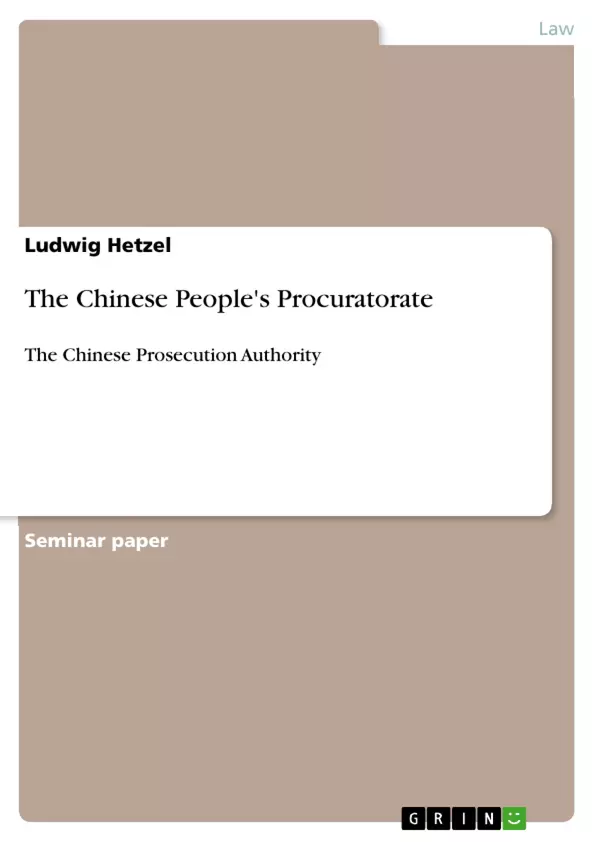The People’s Procuratorates are the Chinese criminal prosecution authorities. Unlike in many other countries, for example in Austria, they are not part of the administrative branch of the government; one could say they are a branch of its own. Another important difference is the additional task of the people’s procuratorates, the legal supervision. In this essay I want to describe how the procuratorate system works, what are the main principles for its organization and what are the major functions of the People’s Procuratorates. In the end I will point out some of the differences between the Austrian prosecution authority and the Chinese People’s Procuratorates are.
Inhaltsverzeichnis (Table of Contents)
- Overview
- Structure of the People's Procuratorate
- Functions and Powers of the People's Procuratorate
- The Necessary Qualification of the People's Procurators
- A Short Overview of the Prosecutorial System in Austria and the Differences to the Chinese People's Procuratorates
- Conclusions
Zielsetzung und Themenschwerpunkte (Objectives and Key Themes)
This essay aims to describe the operational structure, organizational principles, and major functions of China's People's Procuratorates. It will also highlight key differences between the Chinese system and that of Austria.
- Structure and organization of the People's Procuratorates within the Chinese government.
- Functions and powers of the People's Procuratorates, including legal supervision and prosecution.
- Comparison of the Chinese People's Procuratorates with the Austrian prosecutorial system.
- The role of the People's Congress in the oversight of the People's Procuratorates.
- The qualifications and appointment process for People's Procurators.
Zusammenfassung der Kapitel (Chapter Summaries)
Overview: This introductory chapter establishes the People's Procuratorates as the Chinese criminal prosecution authorities, distinct from the administrative branch of government. It emphasizes their unique role in legal supervision and outlines the essay's purpose: to explain the procuratorate system, its organizational principles, and major functions, concluding with a comparison to the Austrian system.
Structure of the People's Procuratorates: This section details the multi-tiered structure of the People's Procuratorates, mirroring the Chinese court system. It explains the hierarchical relationship between the Supreme People's Procuratorate (SPP) and lower-level procuratorates, emphasizing the "dual leadership structure" where procuratorates are accountable to both the SPP and their corresponding People's Congress. The chapter also addresses the appointment process for procurators at various levels, highlighting the roles of the National People's Congress and its Standing Committee.
Functions and Powers of the People's Procuratorates: This chapter outlines the key functions and powers of the People's Procuratorates, emphasizing their role in legal supervision and their authority in handling specific types of criminal cases. These functions include overseeing crimes against the state, investigating serious crimes like corruption, supervising criminal proceedings, and initiating public prosecutions. The chapter highlights the procuratorates' independence from other state organs and their crucial role in crime prevention.
Schlüsselwörter (Keywords)
People's Procuratorates, Chinese legal system, legal supervision, criminal prosecution, dual leadership structure, Supreme People's Procuratorate, National People's Congress, crime prevention, Austrian prosecutorial system, comparison.
FAQ: Comprehensive Language Preview of the Chinese People's Procuratorates
What is the purpose of this essay?
This essay aims to comprehensively describe the operational structure, organizational principles, and major functions of China's People's Procuratorates. A key aspect is highlighting the differences between the Chinese system and its Austrian counterpart.
What topics are covered in the essay's Table of Contents?
The essay covers an overview, the structure of the People's Procuratorate, its functions and powers, the necessary qualifications of its procurators, a comparison with the Austrian prosecutorial system, and concluding remarks.
What are the key themes explored in the essay?
Key themes include the structure and organization of the People's Procuratorates within the Chinese government; their functions and powers, including legal supervision and prosecution; a comparative analysis with the Austrian prosecutorial system; the People's Congress's oversight role; and the qualifications and appointment process for People's Procurators.
What is the structure of the People's Procuratorates?
The People's Procuratorates have a multi-tiered structure, mirroring the Chinese court system. A hierarchical relationship exists between the Supreme People's Procuratorate (SPP) and lower-level procuratorates. A "dual leadership structure" is emphasized, where procuratorates are accountable to both the SPP and their corresponding People's Congress. The chapter also details the appointment process at various levels, highlighting the roles of the National People's Congress and its Standing Committee.
What are the functions and powers of the People's Procuratorates?
The People's Procuratorates play a crucial role in legal supervision and possess authority in handling specific criminal cases. Their functions include overseeing crimes against the state, investigating serious crimes (like corruption), supervising criminal proceedings, and initiating public prosecutions. Their independence from other state organs and their role in crime prevention are highlighted.
How does the Chinese People's Procuratorate compare to the Austrian prosecutorial system?
The essay includes a dedicated section comparing the Chinese People's Procuratorates with the Austrian prosecutorial system, though the specifics of this comparison are not detailed in the provided summary.
What are the keywords associated with this essay?
Key words include People's Procuratorates, Chinese legal system, legal supervision, criminal prosecution, dual leadership structure, Supreme People's Procuratorate, National People's Congress, crime prevention, Austrian prosecutorial system, and comparison.
What is the role of the People's Congress in overseeing the People's Procuratorates?
The People's Congress plays a significant role in the oversight of the People's Procuratorates, particularly the National People's Congress and its Standing Committee in the appointment process of procurators.
What are the qualifications required to become a People's Procurator?
The essay addresses the qualifications and appointment process for People's Procurators, but the specific details are not provided in the chapter summaries.
- Quote paper
- Mag. Ludwig Hetzel (Author), 2008, The Chinese People's Procuratorate, Munich, GRIN Verlag, https://www.grin.com/document/127189



